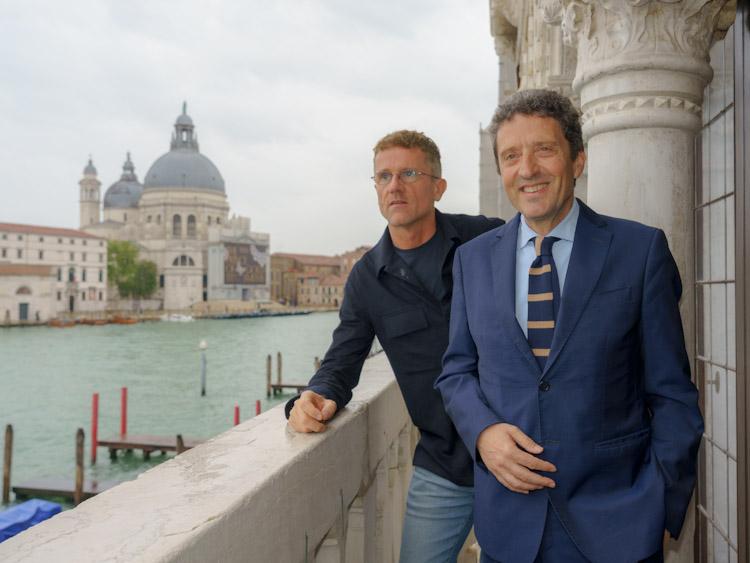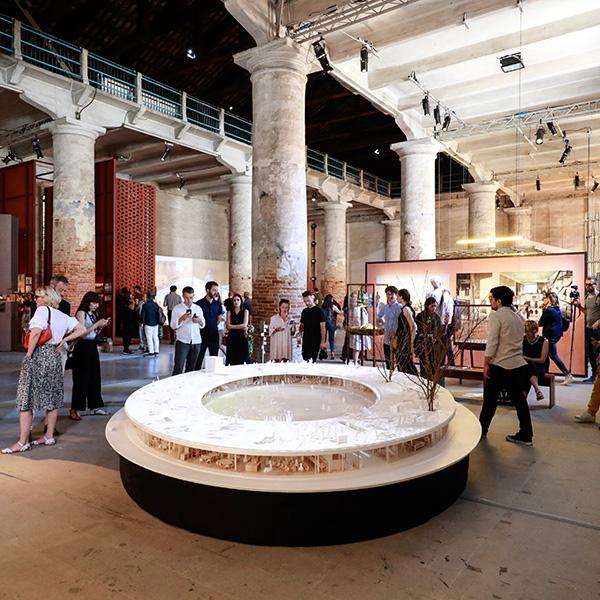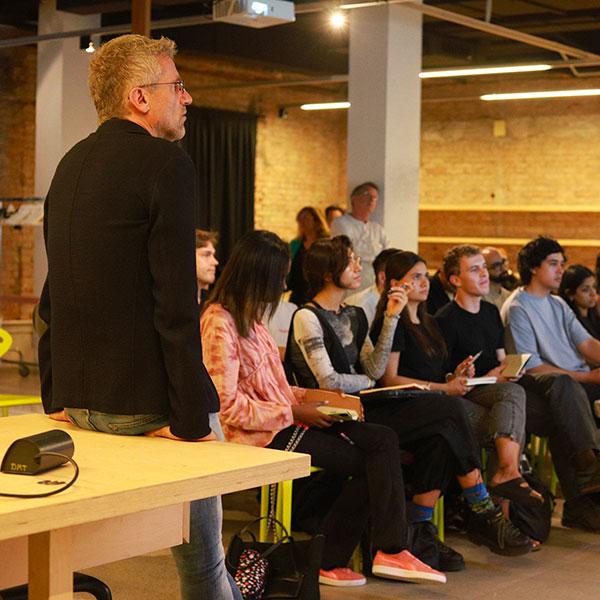The second edition of Biennale College Architettura for students, graduate students and emerging practitioners under 30.

Biennale Architettura 2025: the title is Intelligens. Natural. Artificial. Collective.
Curated by Carlo Ratti. Venice, Arsenale and Giardini venues, 10 May to 23 November 2025 (pre-opening on 8 and 9 May).
19th International Architecture Exhibition
The President of La Biennale di Venezia, Pietrangelo Buttafuoco, and the Curator of the 19th International Architecture Exhibition, Carlo Ratti, announced the title and theme of the Biennale Architettura 2025, which will take place from 10 May to 23 November 2025 (pre-opening 8 and 9 May) at the Giardini, the Arsenale and various venues in Venice.
On the same day, they presented the second edition of Biennale College Architettura for students, graduate students and emerging practitioners under 30, whose workshop will start in September 2024.
The title and theme of Biennale Architettura 2025
The title of the Biennale Architettura 2025 is Intelligens. Natural. Artificial. Collective. Explaining his choice Carlo Ratti said that «the title of the International Architecture Exhibition is usually announced both in English and in Italian. In 2025 it will be condensed into a single word for both languages via the common Latin precedent: intelligens. The title Intelligens is linked to the modern term “intelligence,” but it also evokes a wider set of associated meanings. In fact, the final syllable, “gens” is Latin for “people”. A new, fictional root emerges, suggesting a future of intelligence that is inclusive, multiple, and imaginative beyond today’s limiting focus on AI.»
«The 19th International Architecture Exhibition will be about the built environment and the many disciplines that shape it. Architecture is at the center - Curator explained - but not alone. It is part of an extended sphere that integrates art, engineering, biology, data science, social and political sciences, planetary systems sciences, and other disciplines - linking each and all of them to the materiality of urban space.
The built environment is one of the largest contributors to atmospheric emissions, placing architecture among the main culprits in the degradation of our planet. As the climate crisis accelerates, must we resign ourselves to this role, or are we still able to offer solutions, substantial and non-cosmetic, effective and quick to achieve?
The Exhibition will search for a path forward, proposing that intelligent solutions to pressing problems can take many forms. It will present a collection of design proposals and many other experiments, exploring a definition of “intelligence” as an ability to adapt to the environment with limited resources, knowledge, or power.
Objects, buildings, and urban plans will be arranged along the axis of a multiple and widespread intelligence - organized as natural, artificial, collective, and combinations of the three. While some ideas are destined to fail, others may point us toward redemption.
The Exhibition will cast architects in the role of “mutagens” stimulating natural evolutionary processes and sending them off in new directions. Learning from many sciences, this exhibition hopes to accelerate the transformation of the present through fearless trial and error, and to find a better future in the process».
An Exhibition founded on four methodological pillars
Transdisciplinarity: architectural projects will be collaborations between multiple professionals, with the objective of advancing scientific knowledge whenever possible.
Living Lab: as the Central Pavillion at the Giardini will be under renovation in 2025, it will be replaced by a number of special projects that will leverage Venice and the outdoor areas of the Biennale Exhibition venues as a Living Lab, merging interacting forms of intelligence.
Space For Ideas: at a time of crisis, we need to embrace a collaborative approach to design. As of May 7, 2024, a public venue for the submission of ideas is open on the website of La Biennale, fostering an expansive heterogeneity of voices, visions, and suggestions.
Circularity Protocol: the Exhibition aims to set unprecedented goals for circularity. A Circularity Manifesto will be developed to define clear directions and a new standard for the future of cultural events.
A common prompt addressed by the Curator to the Participating Countries
With the aim to reintroduce a degree of coordination and coherence with the theme of the main International Exhibition among the National Pavilions, the Curator encourages the participating countries to address the common prompt of "One place, one solution”, «showcasing how local ingenuity – Ratti said - can address our time’s existential challenge that can only be tackled in a cooperative manner, reflecting a multiplicity of approaches. If every country brings one success to the table, together we can assemble a global kit for adapting to the future».
The 19th International Architecture Exhibition will present, as usual, the National Participations with their own exhibitions in the Pavilions at the Giardini and at the Arsenale, as well as in the historic centre of Venice.
Statement from President Pietrangelo Buttafuoco
«Meaning and sign converge in the title Intelli/Gens. While intelligence is the foundation of the individuals’ process of evolution, in the most noble sense of their being cives (a third declension noun, thus both masculine and feminine), architecture is the space in which it can unfurl, in a constant negotiation with the territory. Enumerating functions, drawing symbologies, fostering relationships, intelligence builds architecture in ethical, aesthetic and above all ecological terms. It is a fact that, etymologically, oikos in Greek means home but also environment. And that is why in his own statement of intent, Ratti himself asks: “Will we ever be able to design a building as smart as a tree?”
This question is the felicitous heresy of the architect who heads MIT’s Senseable City Lab in Boston, indicative of a pursuit in which circuits and silicon are just a means to return to the origin. Possibly, with greater awareness.
What Ratti gives us is the autobiography of Venice, this Hydropolis that no utopia has ever dared to imagine but that the ingenuity of a people was able to create – in the course of its own history –poetising with nature by virtue of architecture. The city of water is therefore the local model to read at the global scale. A laboratory of complexity par excellence in which to find solutions useful to the entire world. The highest example of Intelli/Gens in which the nature vs. artifice duality has been superseded by the fusion between civilisation and environment.
An organism in the making, therefore, an admirable balance between human and natural history, in which one might perceive the city of refuge envisioned by the reigning Pontiff, Pope Francis, in his historic visit to La Biennale di Venezia, welcomed as “a place of encounter and cultural exchange”.
And from Venice the voyage reaches out all the way to Space, by means of natural, artificial and collective intelligence. An itinerary in the form of a mandate for the year 2025. In which every section is wilfully sealed with a question mark, the punctuation of possibilities and thus abode of the future. The answers to these questions will lay the foundations for the 19th International Architecture Exhibition.»
Biennale College Architettura, second edition
Carlo Ratti, as the Artistic Director of the Architecture Department of La Biennale di Venezia, invites students, graduate students and emerging practitioners under the age of 30 to submit projects that employee natural, artificial, and collective intelligence to combat the climate crisis.
From this global pool of submissions, up to 16 projects from undergraduate and graduate students, young professionals in architecture, urban design, engineering, interior design, landscape architecture, and adjacent professions dealing with the built environment, will be chosen by the Artistic Director to be developed in the Biennale College Architettura programme.
The selected participants will subsequently be invited to join a 10-day workshop in Venice in September 2024 to build up the proposals - including production and budget planning. The workshop will be run by the Artistic Director and/or a group of curators and architects who will act as tutors and mentors for the group. The workshop will alternate between group and individual sessions and dedicated meetings with visiting instructors and cultural producers.
A final selection of up to 8 projects will be finally chosen by Carlo Ratti. A grant of € 20,000.00 for the production will be allocated to each selected project. The works will be presented, out of competition, in the context of the 19th International Architecture Exhibition, Intelli/Gens.
The Goal of this endeavor is, among others, to expand opportunities for young emerging practitioners by sharing their work with a wide audience. After all La Biennale di Venezia has been supporting productions by emerging talents also in the Departments of Art, Cinema, Dance, Music and Theatre and the Historical Archive of Contemporary Arts for a while.
The international call for Biennale College Architettura, published today on the Biennale website www.labiennale.org, will be open until 21 June 2024, 11:59 pm CEST.




